

Table of Contents |
| Exit lines | |
| Exit lines should begin inside the border and span it. For single-track exits, the line should end at the edge of the map. For multiple-track exits, adjust the lines appropriately so that all numbers can be clearly read. Due to a bug, exit lines should not be drawn perfectly vertical or horizontal; if the track should be drawn this way, offset the endpoint by one pixel. | Exit lines should not begin on or beyond the image border, have numbers that overlap, or be so long that numbers are unable to be read. |
| Good
|
Bad
|
| Track spacing | |
| All tracks should be spaced five (5) pixels apart. One pixel is equivalent to moving an endpoint five times when zoom = 0. Spacing on diagonal parallel tracks and through curves can be difficult, so take your time to ensure they're done correctly (study 1159 Howell Yard and 1173 Roanoke to see good examples). The only exception to this is images where tracks have spacing larger than five pixels. | |
| Good
|
Bad
|
| Curves | |
| Curves should consist of approximately equal-length segments, with endpoints forming a series of imaginary radial lines (like the spokes of a bicycle wheel). Use relatively small segments to form a gentle, sweeping curve. Segments should not be shorter than a boxcar. Ensure there is a smooth transition into a curve from the adjoining tangent section. | Curves should not be jerky, with lots of sharp angles. Large segements should be avoided on small-radius curves. |
Good
|
Bad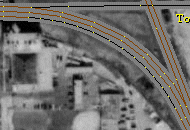
|
| Yard ladders | |
| Yard ladders should consist of equal-length turnouts, although turnout size may vary with different yard ladders. Diverging legs should go straight into the yard track, while the "green" leg should continue straight up the ladder. Tracks should be closely-spaced, except where there are prototypical variations. However, the five-pixel minimum spacing must always be adhered to, which may require that fewer tracks than exist on the prototype be included.Successive turnouts should begin with the straight leg of the previous turnout. Parallel tracks should be of equal lengths and perfectly spaced through yard ladders; long straight sections should not be used in these situations. There should be no short pieces of track between turnouts. | |
Good
|
Bad
|
| Load/Unload lines | |
| All load/unload lines ("sidings"), except for intermodal (and selected others, depending on circumstances), should have a siding number assigned. All sidings should have unique numbers to replicate prototyical spotting orders, with the exception of autorack facilities. Hidden sidings should have a short "approach" load/unload piece assigned to alert the user that a siding is present; this approach piece should not have any cars or siding numbers assigned to it. All intermodal sidings should both load & unload (orange). | |
Good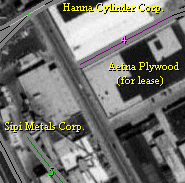
|
Bad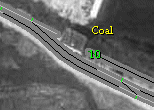
|
| Inspection tracks |
| All yards with repair facilities should have an inspection line on the primary entrances to the yard. |
Good |
| Mainline tracks | |
| Mainline tracks are used to designate the primary routes through a map, and allow trains to move at 60mph. Even if trains do not prototypically move at such speeds on your map, a primary through route must be designated. Mainline tracks are also used to break up yards that are larger than four tracks to make it easier for users' eyes to follow the tracks. | Don't forget to subdivide yards. Ensure that you do not leave gaps in the mainline trackage; these gaps are particularily likely to occur at turnouts. |
Good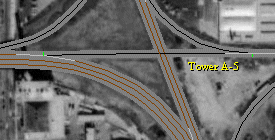
|
Bad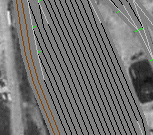
|
| Overhead bridges | |
| When going under a bridge, the edge of the visible track must end at the beginning of the shadow cast by the bridge. It is acceptable to have otherwise short stretches of visible track between bridges remain hidden. It is also acceptable to have hidden turnouts. | |
Good
|
Bad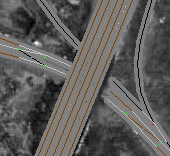 |
| Long straightaways | |
| Long stretches of straight track should be drawn with a single line whose length does not exceed the height or width of the Design window. The only exception to this rule is when the straight track is in a yard ladder. | Using a series of short segments over a long stretch of tangent track will usually lead to minor curves, an annoying visual distraction. |
Good |
Bad |
| Good |
Bad |
| "To..." labels |
| "To..." labels, placed adjacent to exits, identify the railroad which owns the track and where it goes after departing a map. For maps that are adjacent, use the next map's name. When there is a long distance to cover before the next map, use a large city's name. |
| Good Adjacent:  
Separated:
Very separated:
|
| Text type usage |
| Examples of how each of the text types should be used. The lines text
items are attached to should be hidden and drawn diagonally.
|
| Good Building:  
Track:
Street:
Area:
City:
Railroad:
Putting it all together:
|
| Bad Line so short, not even visible: 
City label in improper format; line not diagonal or hidden:
|
| Good |
Bad |
| Good |
Bad |